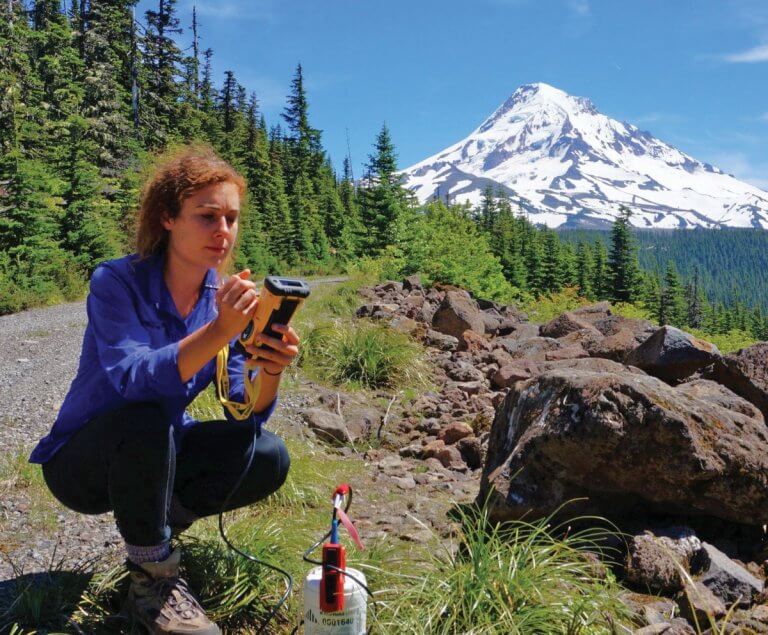
A modern scientific education requires training in scientific principles and techniques coordinated with practice. At the University of Oregon (UO), this practice includes working with faculty in the lab or in the field — discovering new science, building new devices and compounds and creating new analytical techniques.
Students in the Division of Natural Sciences benefit from state-of-the art scientific facilities, laboratories and libraries, faculty who care about research and teaching, and highly-ranked programs that offer both specialized technical training and opportunities to get a broad education.
National stature, “human scale”
Among the faculty, Oregon boasts some of the most accomplished and best-known researchers in the world, including a Nobel laureate in physics. These researchers are dedicated, enthusiastic teachers who love to ignite curiosity and actively mentor the next generation of questioning scientists. Compared to larger universities that share UO’s elite research status, the campus is “human-scale.” Science students have abundant opportunities to receive personalized attention and access to extraordinary resources.

Source: University of Oregon
Oregon faculty and student scholars contribute to the Carnegie Foundation’s ranking of the UO among the nation’s top 115 universities with the “highest research activity.” The University of Oregon is also one of only two Pacific Northwest members of the Association of American Universities (AAU), an invitation-only group whose 62 members in the US and Canada are “recognized as outstanding, by reason of the excellence of their research and education programs.”
Extraordinary natural surroundings
The university is located in Eugene, Oregon. This is a small city of about 155,000 people, located along the Willamette River with a network of hiking and running trails right in the city. The university’s Outdoor Club helps students take advantage of the nearby Cascade Mountains and Pacific Coast, which provide opportunities for hiking, skiing, rock-climbing, canoeing, kayaking and more.
Research and discovery-focused departments
The departments that fall within the sciences at Oregon offer comprehensive educational and research programs, encouraging students to get involved in research projects.
Operating on a principle devised by Wilhelm von Humboldt in the early 1800s, the science departments are committed to combining research with teaching. This principle stresses the importance of learning from faculty who are involved in creating new knowledge. The Division of Natural Sciences has more than 200 faculty members actively engaged in research spanning a broad range of fields — from questions about the foundations of quantum mechanics to the development of cancer cells.

Source: University of Oregon
Students of Biology work in a range of subdisciplines: neuroscientists seek to understand how mice see and fruit flies find their way; microbiologists study cell malformations; students in ecology study evolution and effects of climate change; and marine biologists work on the coast understanding the changes in ocean ecology and their causes.
Many biology students go on to careers in medical fields, in research or in natural resource management.
Students of Human Physiology have access to a cadaver lab for anatomy training, and they work in labs studying recovery from orthopaedic surgery, movement disorders, obesity, heart disease, and athletic performance, injury and recovery — the latter in conjunction with University of Oregon’s world-famous athletic programs.
Students leave prepared to enter their field of choice, whether it’s in medicine, allied health or biomedical research.
The highly-ranked Department of Psychology is one of the top programs in the country. Students and faculty work in four broad areas; clinical psychology, developing understanding of and treatments for psychological disorders such as addiction and depression; cognitive neuroscience, understanding the mechanisms of cognition, such as memory and its disorders; developmental psychology, looking at the way psychology develops with age; and social-personality, how our community affects our psychology and how this varies from person to person.
In the Department of Earth Sciences, Oregon has top-rated programs in Volcanology, Geophysics (including earthquake detection and propagation), and Surface Processes, which are related to the environment, ecology, climate change, etc.
Other attractive and nationally-known programs include Chemistry and Biochemistry (which includes strong Materials Science, Physical Chemistry and Biochemistry divisions), Computer and Information Science (with building strengths in parallel processing, data science, computer security), Mathematics (which has a world leading group in representation theory and also trains students in statistics and applied math), and Physics (with great programs high energy physics, quantum science and biophysics among others).
Supplementing any program of scientific training at the UO involves an array of complementary courses that teach skills like critical thinking, creative problem solving, writing and interpersonal communication. These are vital skills in the workforce and beyond.
Beyond the classroom
To facilitate learning experiences that extend beyond the classroom, the university is creating the pioneering Knight Campus for Accelerating Scientific Impact — a US$1 billion initiative to short-cut the gap between basic scientific discovery and technologies that harness those discoveries.

Source: University of Oregon
According to Around the O, “This game-changing initiative is specifically designed to fast-track scientific discoveries and the process of turning those discoveries into innovations that improve the quality of life for people in Oregon, the nation and beyond.”
Besides this, there are other facilities that support research and practical learning for students, such as the Pine Mountain Observatory, which includes research collaborations with NASA, and the university’s satellite campus on the coast: the Oregon Institute of Marine Biology, where students study coastal and marine organisms and ecology.
International students who choose to study at the Division of Natural Sciences will gain a broad learning experience, coupled with hands-on experiential learning, in the beautiful state of Oregon.
Follow the College of Arts and Sciences at the University of Oregon on Facebook
Follow the Division of Natural Sciences on Twitter
Liked this? Then you’ll love…
University of Helsinki: Eco-innovation and alumni success
International student stories: Studying at Sussex’s School of Life Sciences







